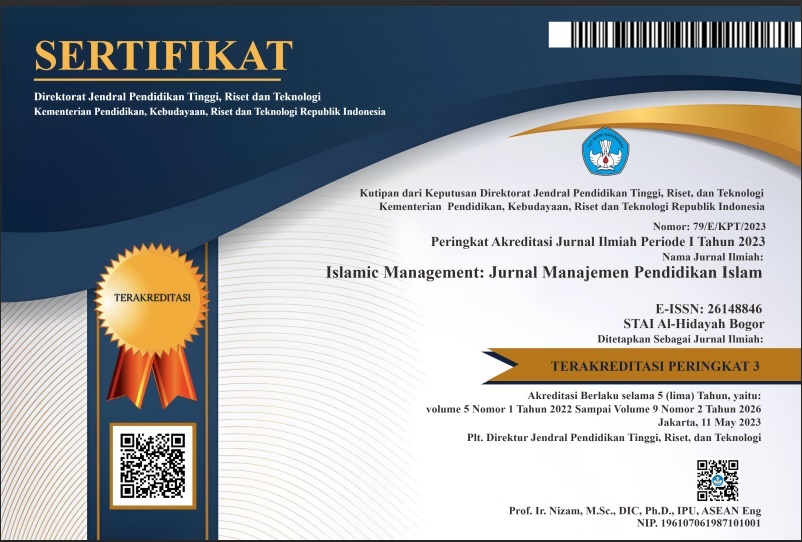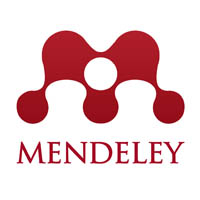INNOVATION AND IMPLEMENTATION OF ADAB CURRICULUM: TA’DIB EDUCATION APPROACH IN CHARACTER FORMATION
DOI:
https://doi.org/10.30868/im.v8i02.8599Keywords:
Adab curriculum, Innovation, Implementation, Character building.Abstract
Character education is very important in the world of education. The development and implementation of a character education curriculum will influence learning activities and the output/outcome produced. This article will describe the innovation and implementation of the adab curriculum at the Ar-Risalah Surakarta Integrated Islamic Elementary School (SDIT) using a ta'dib education approach. This study was conducted using a descriptive qualitative method, employing techniques such as interviews, observations, and documentation. Data analysis utilized qualitative data analysis techniques, including data condensation, data presentation, and drawing conclusions (Miles & Huberman). The findings of this study include: 1. SDIT Ar-Risalah Surakarta innovated the adab curriculum by independently developing an adab curriculum consisting of adab towards oneself, adab towards others, and adab towards the environment. Adab education was incorporated into the intraschool curriculum with an allocation of two hours of class time every week. 2. The implementation of the adab curriculum at SDIT Ar-Risalah Surakarta is divided into three stages: a. the socialization stage, where the adab education program is presented to the entire school community to establish a shared understanding and synergy in its implementation; b. the implementation stage, where adab education is conducted using the concept of ta'dib education as a process of instilling adab and placing students in their proper place, namely at the pinnacle of morality, adab, and ethics. c. The evaluation stage of adab education by conducting assessments to determine whether students have understood the material and are practicing adab education in their daily lives. Key findings from this study indicate that adab education designed independently and implemented systematically can be an effective strategy in shaping students' character. By applying the concept of ta'dib, schools ensure that adab education is not only theory-based but also oriented toward practical application in daily life.
References
Adab, M. (2023). Kurikulum adab Komperhensif Untuk Tingkat Dasar. Arsaka Pres.
Adidarmo, T. (2016). Akhidah Akhlak Madrasah Aliyah XII. PT. Karya Toha Putra.
Afif, N., Mukhtarom, A., Qowim, A. N., & Fauziah, E. (2024). Pendidikan Karakter Dalam Era Digital : Pengintegrasian Nilai-Nilai Moral Dalam Kurikulum Berbasis Teknologi. Tadarus Tarbawy, 6(1), 18–32.
Agung Wahyu Utomo, Mohamad Ali, M. N. R. M. (2023). Konsep Adab Perspektif Al- Ghazālī dan Relevansinya terhadap Pembentukan Karakter. Muttaqien, 4(1), 47–61.
Al-Attas., S. M. N. (1994). Konsep Pendidikan Islam: Suatu Rangka Pikir Pembinaan Filsafat Pendidikan Islam. Mizan.
Al-Attas, S. M. N. (1994). Konsep Pendidikan Islam: Suatu Rangka Pikir Pembinaan Filsafat Pendidikan Islam. Mizan.
Al-Ghazāli. (2008). Ayyuhā al-walad, Misteri Ilmu Nafie’. (Pen. Abu Tsania). Daru al-Hikmah.
Dewi, R. (2023). Konsep Pendidikan Adab Dalam Pembaruan Pemikiran. Risalah: Jurnal Pendidikan Dan Studi Islam, 9(3), 1151.
Husaini, A. (2011). Pendidikan Islam Membentuk Manusia Berkarakter dan Beradab. Cakrawala Publishing.
Husaini, A. (2020a). Pendidikan Islam: mewujudkan generasi gemilang menuju negara adidaya 2045 : kompilasi pemikiran pendidikan. Yayasan Pendidikan Islam At-Taqwa.
Husaini, A. (2020b). Pendidikan Islam Mewujudkan Generasi Gemilang Menuju Negara Adidaya 2045. Yayasan Pendidikan Islam al-Takwa.
Islam, J. P., Abdullah, B., Zaid, A., & Al-kattani, A. H. (2022). Konsep kurikulum adab perspektif Syeikh Bakr Bin Abdullah Abu Zaid. Tawazun, 15(2), 221–238. https://doi.org/10.32832/tawazun.v15i2.7622
Jali, A. N., & W, U. R. (2024). Konsep Adab Menurut Syed Muhammad Naquib Al-Attas. Al-Ulum Jurnal Pemikiran Dan Penelitian Ke Islaman, 11(1), 43–57. https://doi.org/10.31102/alulum.11.1.2024.43-57
Janan, A. A. (2010). Mengungkit Pilar-Pilar Pendidikan Islam (Tinjauan Filosofis). Suka Press.
Julaeha, S., Hadiana, E., & Zaqiah, Q. Y. (2021). Manajemen Inovasi Kurikulum: Karakteristik dan Prosedur Pengembangan Beberapa Inovasi Kurikulum. Muntazam: Jurnal Manajemen Pendidikan Islam, 02(1), 1–26.
Marzuki. (2015). Pendidikan Karakter Islam. Bumi Aksara.
Masykur. (2018). Berguru Adab kepada Imam Malik. CV. Jejak.
Mohd., W., & Daud, N. W. (2003). Filsafat Dan Praktik Pendidikan Islam Syed Mohd. Naquib Al-Attas. Mizan.
Moleong, L. J. (2019). Metodologi Penelitian Kualitatif Edisi Revisi. PT. Remaja Rosda Karya.
Oktaviyenna, H., & Zailani. (2023). Implementasi Pendidikan Karakter terhadap Penanaman Adab di Musleemin Suksa School Hatyai,Thailand. Journal on Teacher Education, 5(2), 479–489.
Permady, D. A., Taufik, H. N., & Mardiana, D. (2023). Pendidikan Adab dalam Membentuk Akhlak Siswa. Edukatif : Jurnal Ilmu Pendidikan, 5(6), 2258–2267. https://doi.org/10.31004/edukatif.v5i6.5734
Rahman, A. (2020). Ruang lingkup inovasi pendidikan karakter di sekolah. Jurnal Pendidikan Kewarganegaraan, 4(2), 179–191.
Salsa Nurhabibah, Herlini Puspika Sari, S. F. (2025). Pendidikan Karakter di Era Digital : Tantangan dan Strategi dalam Membentuk Generasi Berakhlak Mulia sumber informasi. Jurnal Manajemen Dan Pendidikan Agama Islam, 3(3). doi: https://doi.org/10.61132/jmpai.v3i3.1099
Sidik, F. (2020). Hakikat Kurikulum Dan Materi Dalam Pendidikan Islam. Jurnal Pendidikan Islam Al-Ilmi, 3(2), 125–135. https://doi.org/10.32529/al-ilmi.v3i2.547
Yuli Hermawati, Erika Widya Sukma, S. R. (2024). Pendidikan karakter Dalam Era Digital. JAWARA-Jurnal Pendidikan Karakter, 10(2), 8–15.
Downloads
Published
How to Cite
Issue
Section
Citation Check
License
Copyright (c) 2025 Arif Usman Ashari, M Usman, Khuriyah Khuriyah

This work is licensed under a Creative Commons Attribution-ShareAlike 4.0 International License.
Authors who publish with this journal agree to the following terms:
- Authors retain copyright and grant the journal right of first publication with the work simultaneously licensed under a Creative Commons Attribution License that allows others to share the work with an acknowledgment of the work's authorship and initial publication in this journal.
- Authors are able to enter into separate, additional contractual arrangements for the non-exclusive distribution of the journal's published version of the work (e.g., post it to an institutional repository or publish it in a book), with an acknowledgment of its initial publication in this journal.
- Authors are permitted and encouraged to post their work online (e.g., in institutional repositories or on their website) prior to and during the submission process, as it can lead to productive exchanges, as well as earlier and greater citation of published work (See The Effect of Open Access).






